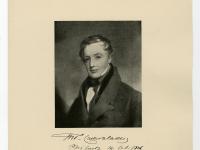Answer: General Thomas Cadwalader.
In early 19th-century Philadelphia, anyone who was anyone knew Thomas Cadwalader. Born in 1779, Cadwalader was an ambitious young man who became a successful lawyer, military officer, and Philadelphia socialite. This is perhaps unsurprising considering that he was the son of General John Cadwalader, who had served under George Washington during the Revolutionary War. Cadwalader graduated from the University of Pennsylvania at the age of 16 and was admitted to the bar in 1801. Three years later Cadwalader eloped with Mary Biddle despite his mother’s objections to the match. He had a successful legal career during which he represented the extended Penn family interests in Pennsylvania and served as a trustee of the Bank of the United States.
Following family tradition, Cadwalader was also active in the military. In 1809, he became captain of the Philadelphia’s Second City Troop. When this troop combined with the First City Troop to form a regiment, he became its lieutenant colonel in 1811 and subsequently its commanding officer. During the War of 1812, he served on Philadelphia’s Committee of Defense and in the camps at Kennett Square, Pennsylvania, and Wilmington, Delaware.
In addition to his legal and military work, Cadwalader enjoyed a prosperous social life. The most accomplished scholars in the country visited his house on the southeast corner of Ninth and Arch Streets. In 1824, he hosted a reception for the Marquis de Lafayette on his return trip to the United States. Cadwalader also counted as close friends Nicholas Biddle, president of the Bank of the United States, and Joseph Bonaparte, the elder brother of the French emperor Napoleon. However, Cadwalader found an enemy in Granville Sharp Pattison, a local surgeon of ill character. In 1823, Pattison shot Cadwalader in the right elbow during a duel; he never fully regained the use of his right arm. He died at the age of sixty-one in 1841.
General Thomas Cadwalader's papers make up a significant portion of the Cardwalder family papers (#1454) at HSP. Legal and military papers form the bulk of his material, but there are also maps, land deeds, correspondence, estate papers, and other miscellaneous items.

